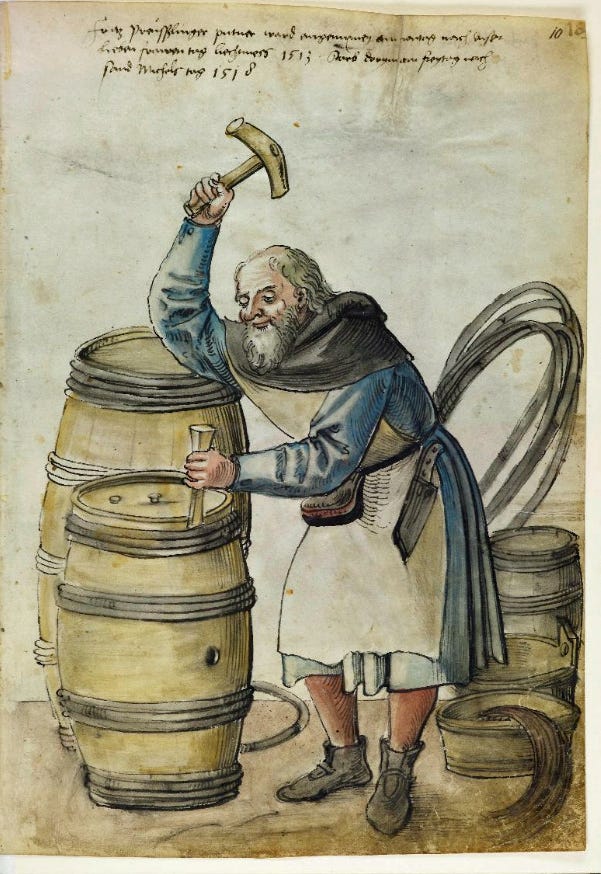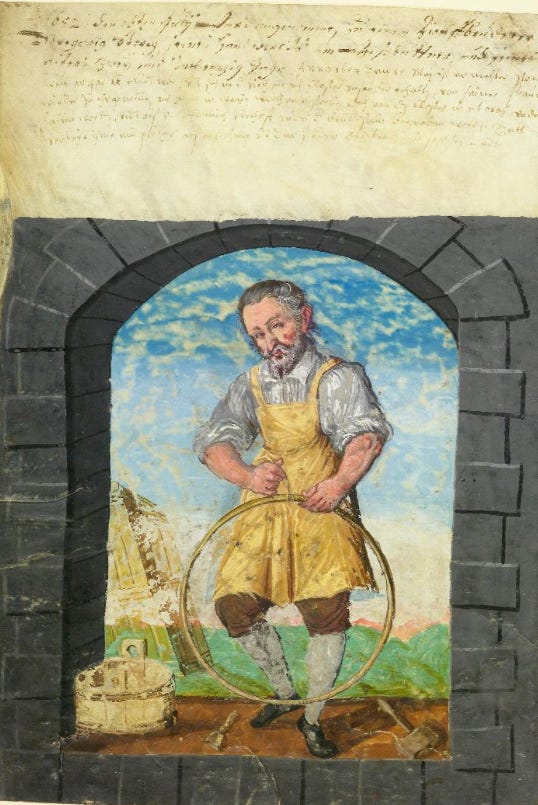Not back to the shop yet, which is fine. I’m working on my craft genealogy book - but here took a break to collect some references from New England 17th century records about cooperage. Tip of the iceberg…coopers were pretty important. This post is free to all - being just a compilation that I pulled together 20 years ago. Got kinda long. I’ve made one or two comments here & there. Hope you like it.
Readers who look at the details will have seen comments left here (and on the old blog) by Bob Trent - I’ve worked with Trent on 17th-century furniture studies since about 1990 - and before I came on board, Bob and Jennie Alexander were in the thick of it for 8 years already. Those Essex County cupboards that I copied during the past couple years are a subject Trent and I have spent a lot of time on. One thing in particular, two maybe, about Essex County in the Massachusetts Bay Colony - it had some very well-heeled people in towns like Salem and Newbury - and a lot of very detailed records have survived and been published.
When I go shopping for a log for furniture work, I know one log will last me months. Then I think about the amount of wood early New England was cutting down then cutting up it’s beyond my comprehension. Recently Trent and I have traded a lot of notes as he’s been re-reading the court records from Essex County and noticed the large quantities of pipe staves being used as a commodity. First - a “pipe” is for storing and transporting wine. The sizes and capacities of various coopered vessels sometimes shifted here and there in the period. Generally a barrel was 36 gallons and a pipe was a barrel and a half - or 54 gallons.
[image is from the Housebooks of Nuremburg - an astounding collection. Fully digitized online here https://online-service.nuernberg.de/viewer/hausbuecher/ ]
Pipe staves - pieces of white oak split to rough size from which a trained cooper could then dress his staves - were in high demand. Some examples:
Will Payne v Robt Tucke and Ed Colcord. Payne promised to pay defendant 40s out of a judgement against Richard Waldern, and if Colcord made up 10,000 pipe staves within two months, to give him 20s more, 2:2:1646.
[Records and Files of the Quarterly Court Essex County, Massachusetts, George Francis Dow, (Salem, Massachusetts: Essex Institute, 1911-21)
So 10,000 pipe staves in two months, essentially 48 days’ work. A pipe stave at that time was about 4 ½ feet long, by 4” wide. Riven white oak. That’s over 200 per day, roughly.
Next one - using pipestaves to pay a fine (or corn, cattle or English goods - seems like they’ll take anything):
1:166: Apr 1649: Sam Greenfield…fine of 6£. With his surety, Edward Gyllman, he bound himself to pay the fine in white oak pipe staves delivered by the water side at Exiter at the usual landing place, where a pinnace may conveniently take them in, and to be culled at Boston, or in corn or cattle or English goods, to be delivered at the clerk’s house in Salisbury.
Next one - seems that Bray Wilkins and his family know their way around splitting wood - here he is in court twice:
3:323: [Salem, June 1666] Richd Bellingham Esq v Bray Wilkins and John Gingell. Trespass for cutting down and ruining the principal timber and great trees on the farm and land mortgaged at or near little Wills hill. Verdict for the defendant. Court did not accept the verdict.
…Bray Wilkins owned then that the past winter he had felled and made from off the said farm six thousand barrel staves for Mr Curwin, etc.
Phillip Knight, aged about fifty-two years, and Jonathan Knight, aged about twenty-four years, both of Salem, deposed that Samuell Wilkins, of Bray Wilkins’ family, informed deponents that they had cut twenty thousand white oak barrel staves the past year, and had cut about eleven hundred feet of boards. Also the year before they cut six thousand feet of boards, etc.
Pipestaves were a marketable commodity throughout New England for the whole 17th century. They were shipped by the tens of thousands for the wine trade.
28 April 1647: Shipped in good order & well conditioned by mee Nicholas Davison of Charlestown in New England Mercht in & uppon the good shipp called the Planter…now at Anchor in the Rode of Boston in New England and bound for the Island of Maderas to say, fifteene thousand three hundred of good sound & merchantable white Oke pipestaves & sixteene tunnes of shaken Caske, to say, in thirty two pieces stroongly hooped & nailed…
[A Volume relating to the Early History of Boston containing the Aspinwall Notarial Records from 1644 to 1651 (Boston: Municipal Printing Office, 1903) p. 75.]
In that record, I think that “shaken” cask refers to dis-assembled cooperage. In another Boston case is this:
18 (4) 1650 Shipped by the grace of God in good order & wel conditioned by mee John Parris in & upon the good ship called the St Martine of Allickmore wereof is mastr under God for this present voyage Martine Jacobs & now riding at Anchor in the River of Charlestowne & by Gods grace bound for the Ile of Maderas to say one hundred sixty fyve kint of dry fish ten thousand two hundred thirty six pipe staves eight hundred of hhd staves…and are to be Delivered in the like good order…at the aforesd port of Maderas …
[Aspinwall Notarial Records pp. 292-3:]
My notes don’t indentify “kint” - after the pipestaves are hogshead staves - a hogshead being two barrels’ worth - 72 gallons. Or so.
A few records from Connecticut and New Haven Colony concern coopers and their wares. Coopers were to be paid about the same wages as carpenters, joiners, masons and blacksmiths.
(c. 1640 in Hartford, Connecticut)
“sufficient able Carpenters, Plow writs, Wheelwrits, Masons, Joyners, Smithes and Coopers, shall not take above 20d for a dayes worke from the xth of March to the xith of October, not above 18d a day for the other prte of the yeare, and to worke xi howers in the day the summer tyme, besides that wch is spent in eating or sleeping, and ix howers in the winter...all other Arificers, or handicrots men and chiefe laborers shall not take above 18d a day for the first halfe of the yeare...and not above 14d pr day for the other prte of the yeare...” J. Hammond Trumbull, ed., The Public Records of the Colony of Connecticut, 1636-1665, (Hartford, Brown & Parsons, 1850) p. 65
Here is a New Haven (Connecticut) record concerning the size of their cask; and the need for it to be marked, etc:
23rd of March 1647
it is ordred that every cooper wthin this plantation shall take care that he make his ware tight and good, and full for gadge, and shall sett his burned marke upon it that his ware maye bee knowne, and allso the just gadge, howe much it holdeth, wch is to be as followeth; the hogshead 64 gallins, but not lesse than 62; the halfe hogshead or quarter cask, 32 gallons, but not lesse than the 30; and the barrell 48 gallons, but not lesse then ----- These all to be marked as they will hold upon tryall, and no otherwise.
[Records of the Colony and Plantation of New Haven, from 1638 to 1649 Charles J. Hoadly, editor, (Hartford: Case, Tiffany and Company, 1857) ]
So those capacities are different from English definitions cited in Randle Holme’s Academy of Armory. Not unusual, those sizes shifted from place to place and time to time. Sometimes the capacites varied according to the product inside the cooperage.
Back to those Connecticut records for a minute:
From: The Public Records of the Colony of Connecticut, 1636-1665, J. Hammond Trumbull, ed., (Hartford, Brown & Parsons, 1850)
p. 60: February iij 1640 “And for the better prsearving of Tymber that the Country may have provisions of Pypestaves for the furthering the said trade of Cotten wool, it is Ordered that no Tymber shall be felled...without lycence of the prticulaer Courte, nor any Pypestaves be sold out of the River wthout allowance fro: the said Courte, nor transported into foraigne prts untill they be vewed...both for the goodness of the Tymber, and due prportion & size thereof...”
p. 67: “...Order for restreyneing of the felling of Tymber is repeled prvided that no Tymber be falen wthin three myles of the mouth of the Matbezeke river nor at unnseasonable tymes vizt: fro: the beginning of April to the end of September and that it be improved into pipestaves or some other merchantable comodity within on month after the felling thereof, or carted together...
...the size of Pipestaves shall be 4 foot 4 inches in length, halfe an inch at lest in thickness, besides the sappe: they are to be 4 inches in bredth, if under to goe for half staves, and none to goe if under 3 inches in bredth...one experieinced man to vew & observe...approved & sealed...£5 the thousand”
p. 79: December 1642 “the size of Pipestaves is to be 4 foote vi inches in length, the breadth and thickness according to the former Order...”
Interesting that they restrict the felling of timber to the winter - might be for several reasons. One of which could be the timber can go bad more quickly in the summer, with insects getting into it & spoiling it. I prefer winter for storing green wood when I have my “druthers.” Or maybe it’s about farming and having more pressing work in season. Or who knows why?
One last one for now - from Boston
Winthrop's Journal: History of New England 1630-1649 James Kendall Hosmer, editor, (New York: Charles Scribner's Sons, 1908) 2 vols.
p. 67: Mo. 5 23 1642 The Mary Rose, which had been blown up and sunk...was now weighed and brought to shore by the industry and diligence of Edward Bendall of Boston. Edward Bendall...if he freed the harbor, should have the whole... He made two great tubs, bigger than a butt, very tight, and open at one end, upon which were hanged so many weights as would sink it to the ground. It was let down, the diver sitting in it, a cord in his hand to give notice when they should draw him up...
Randle Holme says a butt equals two hogsheads - but that doesn’t mean that’s what it measured in Boston. It’s a big coopered vessel that someone was in, diving down to try to clear the harbor.






"Kint' is a phonetic abbreviation of the quintal, the standard barrel that salted and dried cod was shipped in. I try to imagine what kind of vessel could take ten thousand pipe staves plus fifty quintals of cod, bound for the Canaries or the Madieras, aka the Wine Islands. I recall being at the Mayflower replica and hearing a tourist ask what scale the boat was made at. And they were shocked to hear it was full size.
Thrilling twist at the end, there!